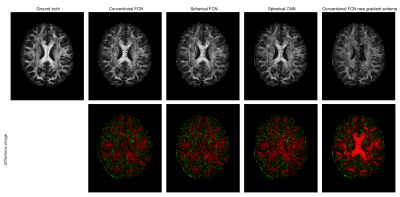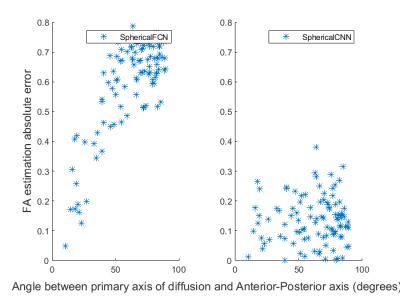2605
Spherical-CNN based diffusion MRI parameter estimation is robust to gradient schemes and equivariant to rotation1Department of Computer Science and Centre for Medical Image Computing, UCL, London, United Kingdom, 2Department of Brain Repair & Rehabilitation, Institute of Neurology, UCL, London, United Kingdom, 3Kagenova Limited, Guildford, United Kingdom
Synopsis
We demonstrate the advantages of spherical convolutional neural networks over conventional fully connected networks at estimating rotationally invariant microstructure indices. Fully-connected networks (FCN) have outperformed conventional model fitting for estimating microstructure indices, such as FA. However, these methods are not robust to changes diffusion weighted image sampling scheme nor are they rotationally equivariant. Recently spherical-CNN have been supposed as a solution to this problem. However, the advantages of spherical-CNNs have not been leveraged. We demonstrate both spherical-CNNs robust to new gradient schemes as well as the rotational equivariance. This has potential to decrease the number of training datapoints required.
Introduction
This work aims to demonstrate the advantages of spherical convolutional-neural-networks (spherical-CNN) over standard fully-connected network (FCN) methods for estimating microstructure indices. Diffusion models permit the estimation of tissue microstructure from diffusion-weighted-images (DWIs). However, signal-noise limits estimation fidelity for conventional models, requiring more DWI acquisitions that is clinically tolerable1. Deep-learning has recently revolutionised diffusion MRI (dMRI) parameter estimation, yielding greatly increased accuracy in comparison with conventional methods2,3. However, current deep-learning models are ignorant of the gradient-direction set adopted by a given DWI acquisition, rendering them inflexible to new sampling schemes. This inhibits the application of a model across data acquired from multiple sources. Moreover, these networks do not enforce rotational-equivariance limiting generalisation from signals along one axis to those along another. Previous attempts to include the relationship between the gradient directions sets and image acquisitions4,5 do not utilize the topological features of the sphere inherent in the fundamental structure of the modelled signal.Spherical-CNNs, recently prototyped in the estimation of NODDI measures6 provide a natural solution to this problem. However, the theoretical advantages of spherical-CNNs, such as rotational-equivariance and robustness to different gradient sets, are yet to be fully exploited. Here we aim to demonstrate these advantages in the context of estimating rotationally-invariant indices of diffusion tensors from six-direction DWIs.
Methods
Study design: We wish to demonstrate two advantages of the spherical-CNN. The first experiment evaluates robustness to differing gradient schemes by altering the order of the gradient scheme at test time. To show this, spherical-CNN is compared against the current standard, a fully connected network (DiffNet).The second experiments aims to show the benefit of rotational equivariance enforced in the spherical-CNNs model architecture by fixing the orientation of the major axis of diffusion to follow the anterior-posterior direction in the training dataset.
Evaluation: In both experiments we compare spherical-CNNs against FCNs. The hybrid spherical-CNN7 has been shown to estimate parameters with high fidelity for a variety of tasks. A version of this model tailored to regression is employed for the estimation of FA. Spherical-CNNs require spherical signals as input. We propose exploiting the 1-to-1 mapping between the six-directional DWI and DT to generate an ADC profile for the input. We compare against two FCN architectures, each with differing input layers. The first, Conventional-FCN, follows the standard procedure of inputting each DWI to a separate node; the second, Sphere-FCN, replaces the input with the ADC profile. Training parameters for all models were consistent with the literature.
The output rotationally-invariant microstructure-index chosen for this demonstration is FA as it is commonly used in the literature. In both experiments an accelerated scan of 6 DWIs is paired with a ground-truth (GT) FA map. These properties are satisfied by data from the Human Connectome Project (HCP) that provides a large number (90) of b=1000. Training was performed with only one participant and, to show generalisation, an unseen subject was tested upon.
In both experiments, the median absolute error (MAE) of the estimates over the whole image were compared, visualising maps of estimates and errors relative to the ground truth. In the second experiment the absolute error was evaluated as a function of angular deviation from the anterior-posterior axis.
Results
Figure 1 shows the comparison of conventional-FCN, spherical-FCN, and spherical-CNN models of FA when the order of the diffusion weighted images corresponding to the gradients is consistent between training and testing. Note minimal differences. However, in the permuted case, where the DWI order of directions does not correspond to the training set, the conventional FCN model performs greatly worse. Note the error is structured, maximal in regions of high FA.Figure 2 shows the effect of estimating full brain volume using networks trained only on tensors aligned with the anterior-posterior axis. For the FCN network the FA is consistently underestimated in regions where the main axis of diffusion does not align with anterior-posterior (e.g. the corpus callosum which consists of transverse white matter tracts). In contrast, the Spherical-CNN estimates FA with high accuracy for tensors in all directions, and the noise is far less structured than that of the FCN. These results are supported by figure 3, where a scatter plot of the FA estimations absolute error is plotted against the angle between the primary axis of diffusion and Anterior-Posterior axis. The error stays low across the whole range of angles for the spherical-CNN, in contrast, the FCN error greatly increases as the angular deviation grows.
Discussion and Conclusion
Representing diffusion-weighted imaging as a spherical signal is here demonstrated to introduce robustness to the ordering of gradients absent from conventional-FCNs, at no cost to fidelity. This removes the need to retrain a new network for every gradient sampling scheme, a feature especially beneficial when combing data from multiple sites. Spherical-CNN is shown to be superior to FCN methods because of its rotational-equivariance property. This enables the network to encode information about the pattern of the signal irrespective of its specific location on the sphere. This obviates sampling of diffusion orientation, reducing the number of samples needed to cover the full parameter space. In further work we shall validate these results across different gradient sets and expand to other microstructure indices.Acknowledgements
No acknowledgement found.References
1. Jones, D.K., 2004. The effect of gradient sampling schemes on measures derived from diffusion tensor MRI: a Monte Carlo study. Magnetic Resonance in Medicine: An Official Journal of the International Society for Magnetic Resonance in Medicine, 51(4), pp.807-815.
2. Golkov, V., Dosovitskiy, A., Sperl, J.I., Menzel, M.I., Czisch, M., Sämann, P., Brox, T. and Cremers, D., 2016. Q-space deep learning: twelve-fold shorter and model-free diffusion MRI scans. IEEE transactions on medical imaging, 35(5), pp.1344-1351.
3. Aliotta, E., Nourzadeh, H., Sanders, J., Muller, D. and Ennis, D.B., 2019. Highly accelerated, model‐free diffusion tensor MRI reconstruction using neural networks. Medical physics, 46(4), pp.1581-1591.
4. Chen, G., Hong, Y., Zhang, Y., Kim, J., Huynh, K.M., Ma, J., Lin, W., Shen, D., Yap, P.T. and UNC/UMN Baby Connectome Project Consortium, 2020, October. Estimating Tissue Microstructure with Undersampled Diffusion Data via Graph Convolutional Neural Networks. In International Conference on Medical Image Computing and Computer-Assisted Intervention (pp. 280-290). Springer, Cham.
5. Park, J., Jung, W., Choi, E.J., Oh, S.H., Shin, D., An, H. and Lee, J., 2021. DIFFnet: Diffusion parameter mapping network generalized for input diffusion gradient schemes and bvalues. arXiv preprint arXiv:2102.02463
6. Cobb, O.J., Wallis, C.G., Mavor-Parker, A.N., Marignier, A., Price,
M.A., d'Avezac, M. and McEwen, J.D., 2020. Efficient generalized
spherical CNNs. In ICLR:International Conference on Learning Representations. arXiv preprint arXiv:2010.11661.
Figures


